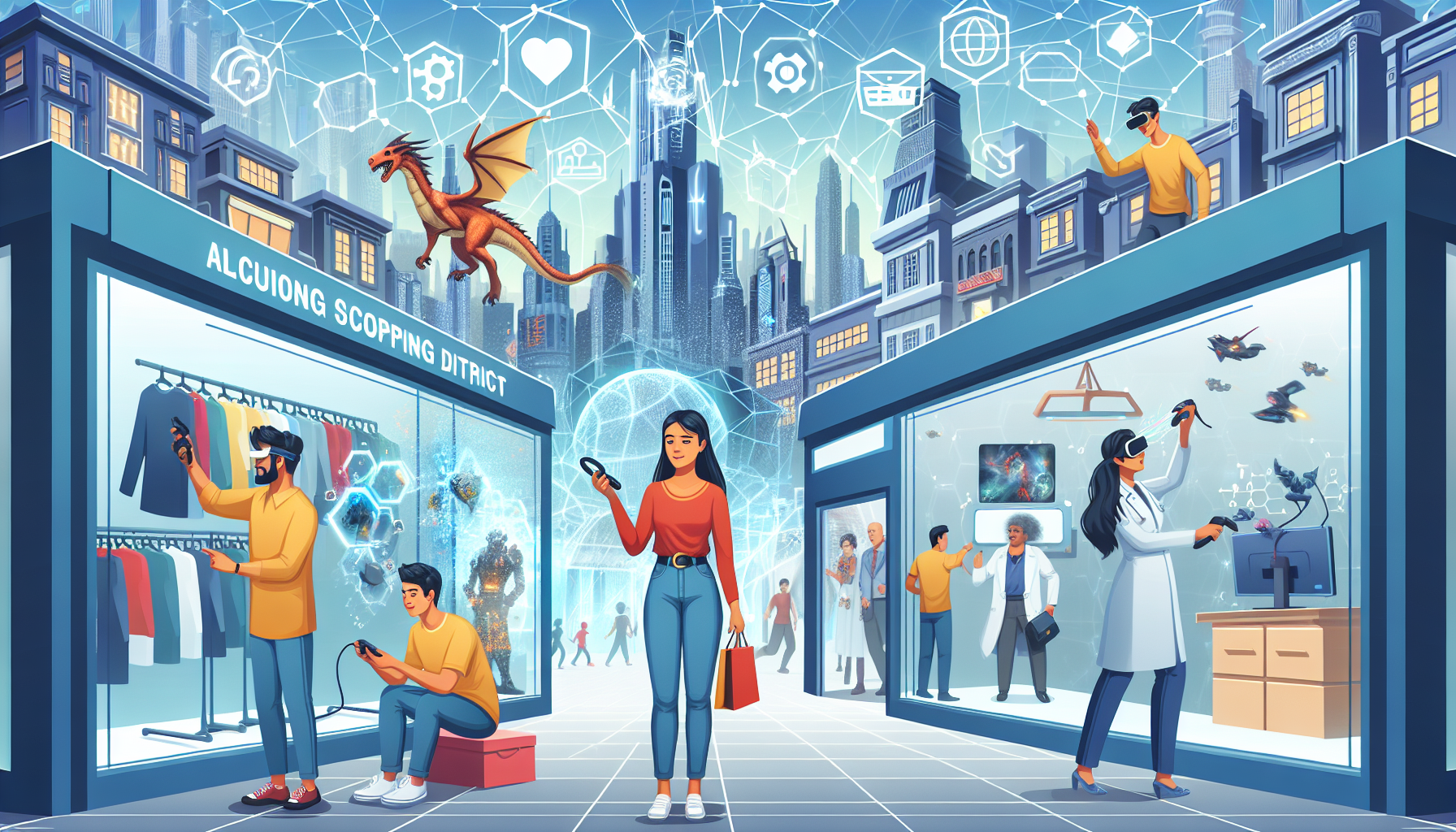The 10 Best Software Development Technologies 2024: A Definitive Guide
Are you poised to integrate the latest and most impactful software development technologies into your work? Discover the ‘10 best software development technologies 2024’, providing strategic insights into the advanced tools and platforms that are anticipated to reshape the world of coding. From paving the way to more secure digital solutions like Krok Travel to enhancing end-user experiences, this curated list not only highlights their significance but also prepares you for what to expect as they unfold throughout 2024. Created by Rubyroidlabs
Key Takeaways
- AI, machine learning, quantum computing, blockchain, and VR/AR technologies are leading trends in software development, enhancing efficiency, security, and user experience.
- Programming languages like Python remain dominant for their ease of use in various applications, while Rust is gaining traction for safety and performance in systems programming.
- The future of application development is focused on sustainability, cross-platform compatibility using frameworks like React Native and Flutter, and crafting immersive user experiences with emotional design and MR/AR integration.
Emerging Software Development Technologies

Exploring the realm of emerging software development trends, the transformative power of technologies such as:
- AI
- Machine Learning
- Quantum Computing
- Blockchain
It becomes evident that these cutting-edge technological advancements are revolutionizing the software development processes, redefining efficiency, security, and user experience in the development process.
Artificial Intelligence and Machine Learning

AI and Machine Learning’s evolution is giving a new shape to the software development landscape. Beyond enhancing efficiency across various industries, these technologies are transforming the software development process. They are:
- Streamlining the design process
- Creating more personalized user experiences
- Influencing product design
- Improving conversational interfaces through AI-enhanced chatbots
- Influencing product design through generative AI
A testament to these advancements are the advanced ChatGPT features and AI-powered coding tools like GitHub’s Copilot. These tools exemplify how AI and ML technologies are improving software development, taking it to new heights of innovation and efficiency.
Quantum Computing

Quantum Computing also stands as a formidable player among the emerging software development trends. This technology, which differs from traditional computing by using qubits and principles like superposition and entanglement, leads to faster data processing. The potential impact of quantum computing in software development lies in greatly increased computational power and the introduction of new encryption methods.
IBM and other leaders like Microsoft and Google are making significant developments in this field. IBM is working on project Condor to achieve 1,121 qubits by 2023, and Google is pursuing a practical universal quantum computer. These advancements indicate that by 2024, we may witness a definitive moment of quantum supremacy where quantum computers solve complex problems more efficiently than classical computers in terms of speed, quality, and power consumption.
Blockchain Technology

Extending beyond cryptocurrencies, blockchain technology is finding applications in a variety of domains like:
- supply chain management
- healthcare
- e-commerce
- publishing
- insurance
- travel industry
This technology is enjoying significant growth, with the blockchain market in financial services growing from $1.89 billion in 2022 to $3.07 billion in 2023.
Enterprises are exploring blockchain for multiple purposes including:
- Identity and access management
- Supply chain logistics
- Smart contracts
- Document management
Despite challenges faced by the cryptocurrency sector, blockchain technology continues to progress in decentralized finance and enterprise solutions.
Some organizations have even started using blockchain to ensure compliance and transparency in ESG areas and to maintain provenance in supply chains.
Virtual and Augmented Reality

Industries such as shopping, gaming, and healthcare are undergoing transformations through Virtual and Augmented Reality technologies. The total value of AR and VR technologies is forecast to grow from $15.3 billion in 2020 to $198 billion by 2025. Impactful implementations of VR and AR are evident in industries such as shopping, gaming, and healthcare.
Wearable AR experiences, such as Apple’s Vision Pro, are progressing to enable interaction with virtual environments via gestures and voice commands. Retailers are adopting AR for virtual try-on features and enhancing online shopping experiences, evolving toward more personalized virtual fitting rooms. This transformation is expected to continue, with advancements in AR and VR technologies paving the way for:
- More immersive and personalized consumer experiences
- Enhanced virtual reality gaming experiences
- Improved training and education through virtual simulations
- Virtual travel experiences that allow users to explore new places without leaving their homes
The possibilities for AR and VR are endless, and we can expect to see even more exciting developments in the future.
Progressive Web Applications (PWAs)
The growing popularity of Progressive Web Applications can be attributed to their:
- Seamless and responsive user experience
- Offline access
- Swift loading time
- Lower development costs compared to native applications
Sophisticated features such as push notifications, background sync, and offline capabilities have been enhanced in PWAs, ensuring users experience continuity even in low network conditions.
WebAssembly in PWAs is bringing a new level of performance and interactivity, aligning the web app experience closer to that of native applications. PWAs are becoming the go-to headless frontends especially for sectors such as e-commerce and enterprise applications, where platform independence is a key advantage.
Low-Code/No-Code Platforms
With speed and efficiency being paramount in today’s era, low-code and no-code platforms are on the rise. These platforms enable software creation with minimal hand-coding, focusing instead on visual modeling and configuration changes.
Low-code and no-code platforms empower non-technical users to rapidly develop applications, requiring minimal coding expertise. This democratizes the software development process, allowing more people to contribute to software development and speed up the development process.
Cybersecurity Advancements
The evolution of digital technologies goes hand in hand with the emergence of new cyber threats. The focus of cybersecurity advancements in 2024 is shifting from reactive measures to proactive security approaches. Developers must implement rigid and secure coding practices to address the evolving cybersecurity threats.
As part of the advancements in quantum-resistant cryptography, the National Institute of Standards and Technology is standardizing the first round of post-quantum cryptography algorithms in 2024. Enterprises are increasingly preparing post-quantum security plans. These advancements underscore the importance of cybersecurity in software development and its intensifying significance due to the software’s integral role in business operations.
Edge Computing
Edge computing also holds a key position in the software development landscape. This technology processes client data at the network’s edge to reduce latency and enhance real-time data processing capabilities. Progressive web applications (PWAs) benefit from edge computing, as it enhances their performance and reliability, especially with an offline-first development approach.
Edge computing brings processing data closer to its source, reducing latency and enhancing real-time data processing capabilities. This is especially crucial in the era of IoT and 5G, where speed and efficiency are paramount.
Sustainable Software Development
Like all sectors, software development too places a high focus on sustainability. Sustainable software development in 2024 focuses on reducing energy usage, minimizing data waste, and contributing to a cleaner society with a lower carbon footprint and minimal environmental impact. As a result, software development services are increasingly prioritizing sustainable practices in their projects.
Sustainable Tech Solutions is a company that focuses on using technology and science to create environmentally beneficial products and services. They specialize in developing solutions that have a positive impact on the environment. They focus on creating eco-friendly solutions, reducing energy usage and minimizing data waste. This shows a growing trend towards sustainable software development, which prioritizes eco-friendly solutions and energy-efficient coding practices.
Human-Computer Interaction (HCI)
Human-Computer Interaction (HCI) leads the way in crafting intuitive and engaging user experiences. Advancements in AI are enriching AR capabilities, particularly in creating realistic human models, enhancing object detection, and facilitating real-time text translation.
Voice User Interfaces are increasingly popular, improving accessibility and inclusivity in human-computer interactions through voice-to-text technologies. The movement toward buttonless user interfaces and the incorporation of motion design are expected to offer more engaging, intuitive user experiences.
With advancements in HCI, we can expect a future where digital products connect with users on a more natural and intuitive level.
The Role of Programming Languages in 2024
Diving deeper into the digital age, the role of programming languages is continually evolving. In 2024, programming languages like Python and Rust continue to dominate the landscape, serving specific areas and industries.
Python’s Continued Dominance
Owing to its simplicity, readability, ease of learning, and versatility, Python continues to be a popular choice among developers. It’s a fantastic language for:
- beginners
- web development
- data analysis
- AI
- scientific computing
Python’s thriving community is reflected in the more than 1 million repositories present on GitHub, indicating extensive community support and widespread use. Leading corporations like:
- Spotify
- Paytm
- Netflix
- Quora
rely on Python for a range of applications, which exemplifies its critical role in the industry.
Rust’s Rising Adoption
Even as Python continues its dominance, Rust is swiftly catching up. Recognized for its ability to provide safe and high-performance computing, Rust is particularly useful in the domains of embedded systems and cloud infrastructure. Its excellent support for multithreading makes it a great choice for writing concurrent programs, overcoming challenges commonly faced in other languages.
Demonstrating its rising popularity within the developer community, Rust has amassed over 729,000 repositories on Github. This growing adoption, particularly in industries prioritizing performance and safety, demonstrates its rising importance in the programming language landscape.
The Future of Application Development
Looking to the future, further evolution is on the horizon for the field of application development. The focus will be on cross-platform solutions, immersive user experiences, and inclusive design principles, shedding light on the path forward for developers and businesses alike.
Cross-Platform App Development
The enhanced performance and user experience of cross-platform applications, making them increasingly comparable to native apps, are driving their growing traction. Frameworks like:
- React Native
- Corona SDK
- Flutter
- Xamarin
- Kotlin Multiplatform
Software applications play significant roles in elevating cross-platform app development, and software developers are the driving force behind this progress.
Cross-platform mobile development frameworks save time and resources by enabling deployment of a single app across both iOS and Android platforms. Python frameworks such as Django, Flask, and Kivy are instrumental in developing cross-platform apps by providing tools for dynamic web applications and innovative user interfaces.
Immersive User Experiences
In the digital age, user experience holds paramount importance. The integration of AR and MR is projected to foster the creation of more immersive and personalized user experiences, particularly with social media platforms currently at the forefront of mixed reality solutions.
Emotional design has become essential in developing immersive experiences by connecting with users on visceral, behavioral, and reflective levels, enhancing user engagement and satisfaction. The industry is moving towards the concept of a Minimum Lovable Product (MLP), prioritizing delighting users from the first interaction instead of just meeting the basic market-entry requirements.
Summary
In a rapidly evolving digital landscape, staying updated with the latest software development technologies is critical. From AI and ML to quantum computing and blockchain, these technologies are shaping the future of software development. Programming languages like Python and Rust continue to dominate, serving specific areas and industries. The future of application development emphasizes cross-platform solutions, immersive user experiences, and inclusive design principles. As we navigate through 2024, the software development landscape continues to evolve, promising exciting innovations and transformations.
Frequently Asked Questions
What is the role of AI and ML in software development?
AI and ML enhance efficiency and revolutionize the software development process by streamlining design, creating personalized user experiences, and influencing product design. They play a crucial role in shaping the future of software development.
How is quantum computing impacting software development?
Quantum computing is impacting software development by offering increased computational power and new encryption methods, leading to faster data processing and significant advancements in the field.
What is the importance of Python in 2024?
Python is important in 2024 due to its simplicity, readability, and versatility, making it widely used in web development, data analysis, AI, and scientific computing.
What are the benefits of cross-platform app development?
Cross-platform app development saves time and resources by allowing deployment of a single app across iOS and Android, while also providing advanced performance and user experience. This makes them increasingly comparable to native apps.
How are AR and MR contributing to user experiences?
AR and MR are enhancing user experiences by providing more immersive and personalized interactions, especially in social media platforms, and are set to revolutionize digital object interactions.